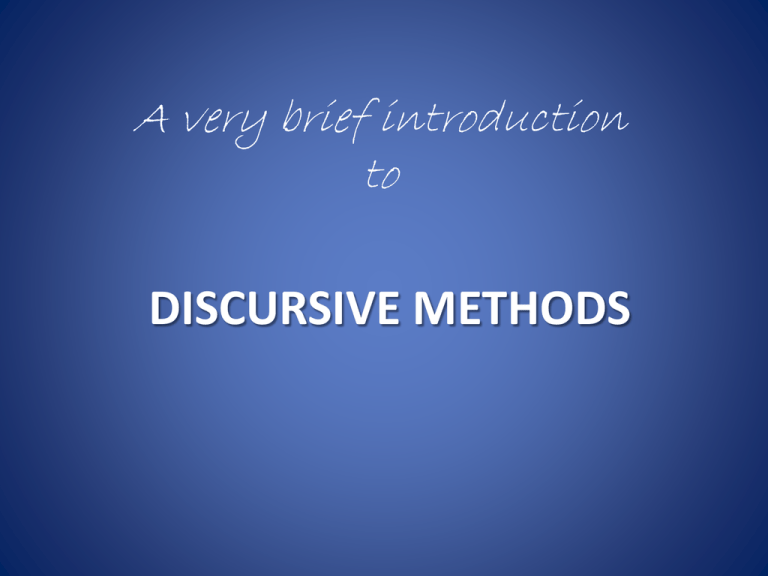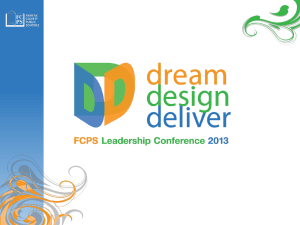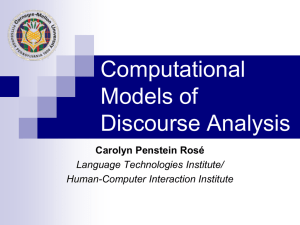DISCURSIVE METHODS - Researcher Education Programme
advertisement

A very brief introduction to DISCURSIVE METHODS DISCURSIVE METHODS •Conversation Analysis •Discourse Analysis •Critical Discourse Analysis Why Language? • The ‘discursive turn’ driven by social constructionism • Discourse as a fundamental, centrally constituting, feature of the social world. “It is through language that we create the real and the good, that we create our histories and our destinies” (Gergen, 2003; 61) Why Language? • Active social beings - understanding of the world achieved in and through participation in the world • Objective ‘facts’ or unalterable ‘truths’ make way for multiplicity of meaning through joint action • Discourse central to meaning making Discourse “‘a communicative event’ including conversational interaction, written text, as well as associated gestures, facework, typographical layout, images and any other ‘semiotic’ or multimedia dimension of signification” (van Dijk, 2001; 98) Discourse Necessary to be clear how distinctions are being drawn – between ‘discourse’ and ‘text’ a ‘materially durable product’ between ‘discourse’ and ‘realm’ e.g. media, science, lay between ‘discourse’ and ‘genre’ e.g. press reports, editorials, readers’ letters between ‘discourse’ and ‘topic’ e.g. terrorism discourse Differences of method, methodololgy and underlying assumptions Conversation Analysis Discourse Analysis Critical Discourse Analysis Differences of method, methodololgy and underlying assumptions • Distinct approaches to examining discourse •Some central differences between them •Powerful debate and disagreement between CA and CDA practitioners CA: The analysis of the structural and sequential organisation of talk-ininteraction, examining only with what can be seen in the data, without engaging in a-priori assumptions about the wider social. CDA: Situating discourses within a socio-political context and examining the distribution of power are fundamental features of CDA Differences of method, methodololgy and underlying assumptions •But …. they are all conceptualise language and discourse as social action and consider the analysis of discourse as having central importance for understanding the social world •Perhaps….. a spectrum of discursive methods, each distinct from the other but not mutually exclusive Conversation Analysis • Seminal work of Harvey Sacks ‘Lectures on Conversation’ • Language as social action • Naturally occurring talk-in-interaction is systematically organised • Specific social business expectable and achievable Conversation Analysis • Only study naturally occurring data. • Interested in the ‘utterance’ not the grammar/sentence • Concerned with the real-life activities that people perform with their utterances • Only focused upon the data – no social critique This is Mr Smith may I help you I can’t hear you This is Mr Smith Smith Conversation Analysis Areas of Research: • Preference Organisation (e.g. agreeing and disagreeing; dealing with invitations and requests, managing rejection, pursuing a response) • Topic Organisation (e.g. eliciting a topic, topic transitions) • Aspects of Response (e.g. laughter in talk about troubles, public speaking and audience response: inviting applause Discourse Analysis • Emerged out of early SSK work. Gilbert & Mulkay (1984) ‘Opening Pandora’s Box’ • Marked a departure from realist accounts of scientific knowledge • Language is used variably. Accounts are fundamentally tied to context and designed to achieve particular social business Discourse Analysis - Discursive Psychology • Loughborough University pioneers in the field. Building on Speech Act Theory (Austin, 1962), Conversation Analysis (Sacks, 1992) , Ethnomethodology (Garfinkel, 1967), Social Constructionism (Gergen 1985) • Renamed Discursive Psychology (DP) by Edwards & Potter (1992). Discourse Analysis (DA) considered to be misleading: too many perspectives similar name. However the name DA is still in use. Discourse Analysis • Examines ‘devices’ that operate in discourse (e.g. contrast structures, footing, stake and interest, variable vagueness) • Focus on language as purposive rhetorical business • Interested in many of the same things that traditional psychology studies: memory, emotions, social behaviour , gender • Works with naturally occurring conversation, forms of printed text, interview transcripts Critical Discourse Analysis • Emerged from critical linguistics • Not a singular method – diverse approaches • Concerned with relations of power within social structure • Discourse analysis “with an attitude” (van Dijk, 2001, p. 96) Critical Discourse Analysis Guiding Principles • • • • CDA addresses social problems Power relations are discursive Discourse constitutes society and culture Discourse does ideological work Critical Discourse Analysis Guiding Principles • Discourse is historical • The link between text and society is mediated • Discourse analysis is interpretative and explanatory • Discourse is a form of social action Example 1... 1 2 3 4 5 6 7 8 9 10 11 12 13 14 15 16 17 M.B: Patrick ↑stay with us I want to bring in Shami Chakrabarti of Liberty (0.2) uh:: to get ↓her reaction to what you have to say fi-fi-first of all er Shami uhm good morning to you (.) S.C: and to you Matthew= M.B: =uhm P-Patrick Mercer suggests that he would liked to have seen more armed police (.) more dog patrols on the underground th-this morning on the critical state of alert we are at (0.2) d’you think that would be a↑good scheme (0.2) S.C: .hh well I mean Patrick Patrick has an operational (0.2) uhm experience which-wh-which I don’t but I (.) I am grateful to him and (0.2) frankly to your callers (0.2) I want to vote for Kevin from Southampton to ah (0.2) .hh to join Mr Brown’s government of all the talents (0.2) this is one of the more (0.2) thoughtful conversations about er dealing with the terrorist (0.2) threat that I have ever parti↑cipated in I think (0.2) .hh Example 2 1 2 3 4 5 6 7 8 9 10 Evolutionary psychology stresses both the universality of most human traits and - through the notion of kin selection and reciprocal altruism the instinct to favour our own. Social psychologists also argue that the tendency to perceive in-groups and out-groups, however ephemeral, is innate. In any case, Burkeans claim to have common sense on their side They argue that we feel more comfortable with, and are readier to share with and sacrifice for, those with whom we have shared histories and similar values. To put it bluntly - most of us prefer our own kind. Example 3 1 2 3 4 5 6 7 M.B: [lemme-hang on-Jack–le hang on-okay-now-now-now to y(h)ou (0.2) let me just bring in Charles Shoebridge who’s a bit of an expert on these matters err Jack to cast a little bit of (0.2) .hhh light as well as heat on the-on the issue (0.2) um he’s a security analyst and former counter terrorism intelligence officer (0.5) .hhh umm ↑Charles d’you have a different view about the threat that we’re facing toda:y than you did (0.5) y’know a week ago? (14:15) Example 4 1 2 3 4 5 6 7 Moreover, welfare is less re-distributive than most people imagine – most of the tax paid out by citizens comes back to them in one form or another so the amount of the average person’s income going to someone they might consider undeserving is small. This, however, does little to allay anxieties based on perceptions rather than fiscal truths. And poor whites, who have relatively little, are more likely to resent even small transfers compared with those on higher incomes Discursive Methods A selection of methods through which it is possible to examine social phenomena as achievements of active human interaction • Structural features of talk in interaction – CA • Purposive rhetorical business of social interaction - DA • (Re) production of social structures (unequal power relations) in and through social interaction - CDA Questions? References Gilbert, G. N., & Mulkay, M. (1984). Opening pandora's box: A sociological analysis of scientists' discourse. Cambridge: Cambridge University Press. Potter, J. (1996). Representing reality: Discourse, rhetoric and social construction. London: Sage. Sacks, H. (Ed.). (1995). Lectures on conversation. (Volumes 1 & 2). Oxford: Blackwell Wetherell, M., & Potter, J. (1992). Mapping the language of racism: Discourse and the legitimation of exploitation. Hemel Hempstead: Harvester Wheatsheaf. Wodak, R & Meyer, M. (Eds.), Methods of Critical Discourse Analysis. London: Sage








